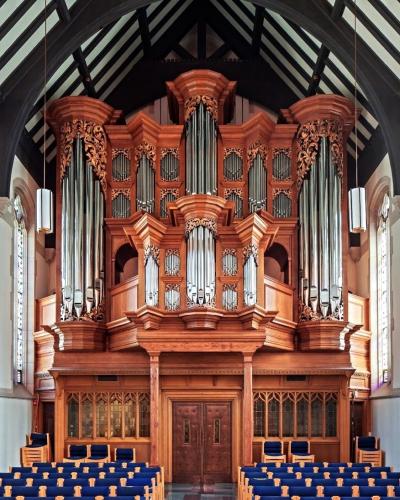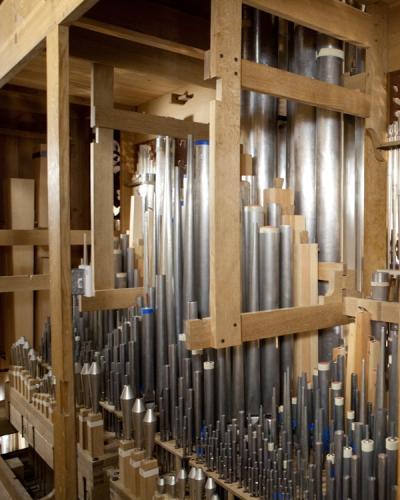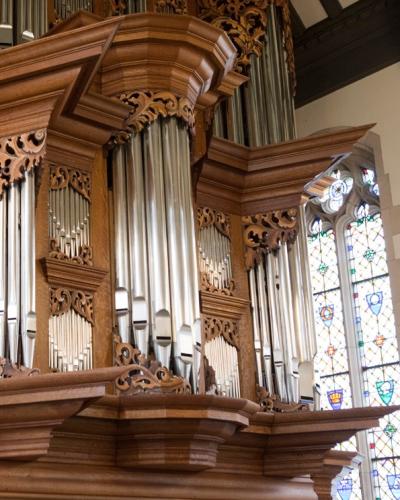"What I love about Cornell’s Baroque Organ (aside from that it is crafted both in Sweden, from where some of my family hails, and near us here) is that the architecture of Anabel Taylor Hall is such that one seems to enter the chapel through the organ. Which is just right, for then, when the sounds flows majestically from its pipes, one is already there, emotionally in the organ, one with the music.
– Roald Hoffmann (Frank H. T. Rhodes Professor of Humane Letters and Nobel Prize Winner)
Since its inauguration in 2010, the Baroque Organ has contributed to musical and scholarly life at Cornell across the disciplines. Read here the many ways the instrument inspires research and engagement at the university.
An Organ for the Humanities
Speaking in 2010, Peter Lepage, then Harold Tanner Dean of the College of Arts and Sciences, described the organ as a physical manifestation of the humanities at Cornell: “The organ really is a piece of academic research… the organ is not only beautiful, but is also connected in a very profound way to culture. It connects us to the beginning of the 18th century, to the very vibrant culture of 1706 when it was created. I think that kind of historical resonance resonates very powerfully with what we do in universities, and what we do in the Colleges of Arts and Sciences, particularly in the humanities. A significant role of the humanities is to preserve, remember, and understand culture: this organ is almost a physical manifestation of that mission. Every time it is played, every time we listen to it, we will be participating in that exercise, which is so fundamental to what we do in the humanities.”
German Studies
“When I first heard Cornell’s new Baroque Organ played, I got goose bumps because history really does come alive in this extraordinary project,” writes Leslie A. Adelson, Jacob Gould Schurman Professor of German Studies and then Director of the Institute for German Cultural Studies at Cornell’s College of Arts and Sciences. “For the study of German culture it offers a treasure trove of insights into the science and technology of artisanal craft, the history and phenomenology of a nation’s musical taste, the importance of German feet and pedals for sound cultures in Europe, the emergence of middle-class public culture, urban losses in modern warfare, and even the global value of sustainable forest in a country where live oak has symbolic value too. What Cornell now offers as an inspiring and moving musical experience also opens a rather large window onto early modern and modern German cultures.”
Speaking in 2010, Anette Schwarz, Associate Professor and then Chair of German Studies, discusses the cultural and interdisciplinary studies possible with the Baroque Organ.
Materials Science Research
Sheford Baker, Associate Professor of Materials Science and Engineering, discusses scientific questions raised by the organ:
“The organ is a big, complex thing. The air has to go through lots of different passages, and you have to be able to control all this with the touch of a single key, just like an electronic keyboard… and it has to be responsive to the organist. How you get all of this mass and wind coordinated in a way that people can play with a delicate touch, that’s an engineering controls issue, and a fascinating one. From the acoustics side, the materials that the pipes are made out of, the way they are formed, the way the case is made––all of this affects the acoustics and how the instrument sounds, so there’s a lot of room for research there. I am interested in how you control the structure and properties of materials to get a sound or effect that you like. When an organ like this was built, this was done by trial and error. In the last thirty years or so, we have developed the tools to examine those problems from a scientific perspective.”
Here Baker discusses materials research on corrosion:
Music
Through its very construction, the Baroque Organ offers students the opportunity to learn through practical engagement with the instrument. Throughout history, organ builders have striven for a steadier sound and to silence the noise of the key action. Modern organs have achieved this goal to a fault, according to builder Munetaka Yokota. “Modern organs are easy to play and consistent,” he says. “No matter what you do it sounds good. But they're missing the expressiveness old organs have.” Music written for old instruments assumes a greater level of control over the sound than modern organs provide, as well as certain limitations modern instruments don’t have. “Because modern organists don’t have these limitations and experiences, they can’t reflect how the music was written to be performed,” says Yokota. “The sound and action and how old instruments play all goes together.” It’s virtually impossible to teach old techniques of playing on a modern organ since they don’t respond the same way. That’s why Cornell’s Baroque Organ has such important pedagogical value. “You must have the organ giving feedback,” says Yokota. “The organ itself is the best teacher.”
In addition to its role as a teacher for organists keen to perform early music, the organ has also continued to inspire new music from the composers of Cornell’s Music Department. This commitment to contemporary music began at the inauguration, where University Organist Annette Richards performed a special work Anacrusis, written by Kevin Ernste, Associate Professor of Music and Director of the Cornell Electroacoustic Music Center. Composed to invoke the anticipation and suspension of time that happened in the construction of the organ, Anacrusis used the sounds of woodwork and construction alongside recordings of other Cornell organs, in Ernste’s words, “welcoming a new sibling… an amalgamation of all of these voices coming together.”
Testimonies from Students
“I came to playing the organ at Cornell after first having been a pianist for many years and after having taken a few years of harpsichord lessons. I loved the intimate sound of the harpsichord and was at first uneasy with the organ’s seeming bombast and power. Given the array of possible registrations, from flutes to trumpets to viola de gamba, I soon realized that the colors, sound qualities, and atmospheres the organ can create, especially the mighty Baroque replica in Anabel Taylor Chapel, were infinite. Its versatility as an instrument has continually surpassed my expectations. I have played on that organ during times when I needed quiet contemplation; I have come to know my own inner strength when all the stops are pulled; I have learned to coordinate my feet with my hands with my head, all parts of my body working together in a way the clumsy everyday me could never quite learn how to do. I must also mention the organ’s action––or, the way the key feels under the finger when it is pressed. It is quite a heavy action and you can feel the pipes opening and closing when you press each key in a way you can’t on many other organs. In other words, you feel the mechanism of this organ in your very body, as if your fingers and feet were extensions of the keys themselves. You feel the vibration of the pedals in the low registers. You are engulfed by the sounds you are creating. As is so important to many of us interested in historical performance, this instrument also helps you tap into the way it might have felt to play Bach or others in the 18th century––which, if you think about it, is quite spooky. To say that this instrument has impacted my individual studies isn’t giving it enough credit; this instrument has been fundamental to shaping my emotional and intellectual life at Cornell these past six years. In fact, I would not be the same person I am today without having had the opportunity to learn this magnificent instrument.”
– Erica Levenson (Cornell Alum, Ph.D. in Musicology)
“The way the music reverberated off the walls gave me the impression that I was completely encapsulated by sound, in a very warm and comfortable way… I noticed how remarkably odd this instrument really is. Normally at a concert, you can see the player physically doing something to make the sound. On this organ, the only cues we have are auditory. The organ is entirely stationary, a great wall of pipes that create sound out of seemingly nothing. Looking at it long enough, my mind kind of detached the sight of the organ from the sounds, in a way that I felt as if I only heard sound coming from the walls of the chapel.”
– Lee Swindell (Cornell Alum, Class of 2017)
“Personally, the Cornell Baroque Organ had a big impact on me. My grandmother is an organist, so I had been exposed to the organ since I was young, but the opportunity to be up close and personal and actually learn to play such a magnificent organ got me hooked. First, my previous organ experiences were with electro-pneumatic organs, and because of the mechanical disconnect (and therefore lack of feedback) between the keyboard and the pallets I found it difficult to be expressive in my playing. The Anabel Taylor Hall (ATH) organ has mechanical tracker action, which means that you can feel the air beginning to rush past the pallet as you press a key down. I loved having such a deep level of interaction with the instrument; it’s not just your fingers sending commands to the organ, the organ also talks back. Second, the organ is complex and has personality. The prominent effects that humidity, temperature, and air pressure have on the sound of the organ adds to the feeling that the organ is alive. Different environmental and musical contexts change the sound of the organ and the feel of the action, just like, as musicians, different contexts influence our moods and the music we produce. Lastly, the design and voicing of the organ is superb. When I read Baroque organ scores, I always have a sort of sound/timbre in my head, and the tricky part of registration is making that soundspace a reality. Of course, this is a highly subjective thing, but to me the ATH organ is perfect for playing Baroque music. The higher harmonics are well balanced in the upper registers and mixtures and the lower registers have awesome gravitas, which makes playing anything with multiple voices a lot of fun. You can actually distinguish the individual voices instead of them just becoming a mush of harmonics. I remember staying until 3AM because I couldn’t tear myself away from the instrument. Of course it’s pretty difficult to find a similar instrument in Minnesota, so I’ve spent some of my free time since trying to better understand how the ATH organ works, and how I might be able to replicate its sound through more modern manufacturing techniques. I’m doing a PhD in bioinstrumentation engineering, and I have the benefit of a fully equipped fabrication laboratory to support my side projects.”
– Keiran Cantilina (Cornell Alum, Class of 2015, later graduate student in Bioinstrumentation Engineering at the University of Minnesota)



